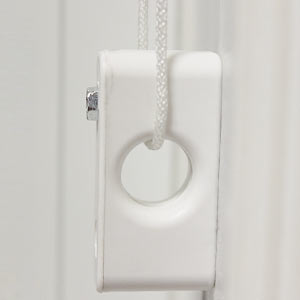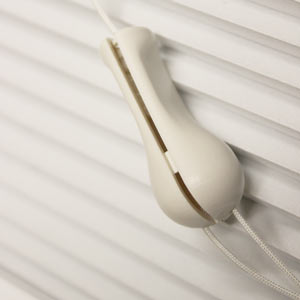Child Safety Updates For Corded Window Coverings
The Consumer Product Safety Commission (CPSC) found that two-thirds of window covering cord accidents ending in death could have been prevented by simply making the cords inaccessible to children. Cordless window coverings are the safest choice for homes with small children. However, if replacing corded window coverings is not an option, safety components are available to improve their safety when installed and used properly. However, choosing not to install, or installing them incorrectly, can create serious hazards for your family.
Here’s what you need to know:
Safety Compliance
Always make sure that every blind or shade you purchase is compliant with CPSC safety standards. Purchasing non-compliant window coverings will create unnecessary risk for your children. The best way to confirm compliance is to know the regulations yourself. Corded window coverings can either have one or two separate cords or have a tensioner for those window coverings with a continuous cord loop lift system.
Keep in mind that even if the window coverings you choose are compliant with safety guidelines, corded blinds and shades can still pose a threat. However, minimizing and avoiding that danger is easy. Here’s how to do it:

Cord Cleats
A cord cleat is a plastic or metal safety device that allows you to wrap dangling cords so they’re out of the reach of children. Corded window coverings can be made safer for children and pets by simply adding a cord cleat to each window blind or shade. SelectBlinds.com provides cord cleats with every corded product order. If you did not receive cord cleats with your corded product order, please call our customer service team at (888) 257-1840.
Ready to install your own cord cleats? Follow these easy instructions.
Additional Safety Components
Tensioners

A cord tensioner is a device specific to blinds and shades with a continuous cord loop lift system. A cord tensioner is a safety mechanism that can be installed on your wall or to your window frame. Every safety-compliant window covering with a continuous cord loop will have a cord tensioner already attached. You simply have to attach it to the wall or inside the window frame. The cord tensioner will keep the cord tight, so a child can’t stick their head or any appendage into the loop. Even with a taut cord, your window coverings will be perfectly functional while keeping your family safe.
Here are step-by-step instructions on how to properly install your own cord tensioner.
Breakaway Tassels

Breakaway tassels can be installed at the end of two single cords to make it a loop. Doing so may make it easier to use the blinds or shades. However, if any weight is put on the breakaway tassel that connects the two cords, it will break apart and you’ll have two unconnected cords once again.
Inner Cord Stops

Added to the safety regulations in November, 2000, inner cord stops can limit how the inner cords can be pulled and looped. If your current cord stops allow too much inner cord to be pulled out, simply adjust the location of the cord stops by untying the current cord stop, moving it to the top of the blinds when the blinds are fully lowered, and retying it onto the cord. Many people forget that it’s not just the main lift cords that can cause injury or death. Every cord on your window coverings has that potential, but the inner cord stops limit that risk.
Free Retrofit Kits
If you have older blinds or shades and they have a cord, you can always use a retrofit kit if you can’t upgrade to cordless blinds right away. Federal regulations dictate that a continuous cord loop must be attached securely to the wall with a tensioner or be cut into two cords with safety tassels added to the bottom of each loose cord. After that, use a cord cleat to keep it out of reach of children. The Window Covering Safety Council (WCSC) offers free retrofit kits, so you can make your current blinds and shades as safe as possible, until you’re able to upgrade to a cordless option later.
Proactive Furniture Placement
But there’s even more you can do to protect your children and pets from accidental strangulation and other injuries. Furniture placement is crucial to your child’s safety. Avoid placing couches, chairs, and other furniture near windows. Children can and will climb up bookshelves, tables, and on chairs. If there is a window blind or shade in reach, they probably will play with it. After all, they’re children and children love to explore. That’s their way to learn and understand the world around them. Proactive furniture placement is a great way to create an even safer home environment for your entire family.
Check and Recheck Cords
Regularly check and recheck the cords on your window blinds and shades. Check that the tensioners are still securely attached to the wall and make sure cord cleats are installed out of the reach of your children. You may need to adjust these as your children grow. Checking and rechecking safety measures in your home will bring you peace of mind.
Everyone should feel safe within their own home, and making sure your window coverings are not potential hazards is where it all begins.
